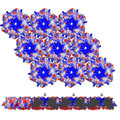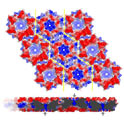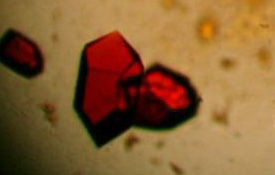
Structural Genomics Program
The structural characterization of proteins of unknown function can be described as structural genomics, an approach in which structure determination by X-ray crystallography supplies key functional information. This is exemplified by studies of the carboxysome. The structures of the first carboxysome shell proteins (Kerfeld et al., Science 2005) confirmed earlier hypotheses that they are indeed the basic building blocks of the carboxysome shell; the quaternary structure and the higher order assemblies of the proteins in the crystals provided insight into how they assemble into shell facets. Likewise, our structure of the carboxysome component CsoS3 revealed that it was a member of the beta-carbonic family, despite having no detectable sequence homology at the level of primary structure (Sawaya et al. Journal of Biological Chemistry, 2006). In this case, the fold of the protein could be used as the basis to assign function and an evolutionary relationship that was no longer apparent at the level of primary structure.





Left to right: Electron micrograph of carboxysomes provided by Allison M.L. van de Meene (Rothamsted Research) and Wim F.J. Vermaas, (Arizona State University), quaternary structures of carboxysome shell proteins, space-filling model of a shell protein pentamer, and ribbon diagram of a shell protein pentamer.
Our research applies structural biology to test hypotheses generated by bioinformatics. Comparative genome analyses have shown that many bacteria have the potential to form carboxysome-like structures, revealing that there is a heretofore unknown variety of metabolic modules within bacteria. These organisms appear to encapsulate various proteins of unknown function within a carboxysome-like shell. Collectively, these proteinaceous organelles are known as bacterial microcompartments. Many bacteria of DOE mission relevance contain bacterial microcompartment genes, but the functions of these organelles are unknown. By determining the structure of the components, we hope to understand the function of these diverse bacterial microcompartments. Structure-based hypotheses about function can be corroborated by biochemical assays and non-homology-based computational methods.
Characterizing the versatility of bacterial microcompartment structure and function is a core focus of the research in the Kerfeld laboratory. Interestingly, a significant fraction of proteins predicted from genome sequences have no assigned function. We are using a variety of approaches to provide functional annotations to proteins in (meta)genomic data. Our group, through a collaboration with the Midwest Center for Structural Genomics, is testing the potential of a wider application of structural biology to deduce function from structure. Members of the JGI User Community have been asked to nominate targets from their genome and metagenome sequences for protein expression, purification, crystallization, and structure determination. The structural descriptions will not only provide opportunities for researchers to discover the biochemical function of proteins and their distant evolutionary relationships but will also, in the case of enzymes, be used to predict and model substrate interactions. More generally, knowledge of an increasingly complete repertoire of protein structures will improve the understanding of the structural basis of protein function structure, inform structure prediction methods, lead to new design strategies and ultimately lend insight into molecular interactions and pathways.


Photograph of an orange carotenoid protein (OCP) crystal (approximately 0.5 mm across),
and a ribbon diagram of the atomic structure of the OCP (a dimer).
The Kerfeld laboratory also has a number of projects related to autotrophy in cyanobacteria, including studies of carotenoid-binding proteins. These organisms serve as model systems for photoautotrophy in higher plants and provide insight into strategies for photosynthesis, photoprotection, and nitrogen fixation.
Members